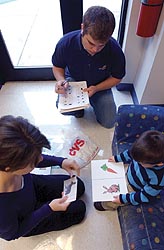

In Class
How Do Children Learn?
Students in a College course explore how children think. By Scott Hauser
 |
| WHY?: Roberts leads a toddler through the study while Whiteside takes notes. |
The 3-year-old boy looks closely at the cards as Stephanie Roberts ’06 shuffles through the deck of images of animals and household items. Nearby, Greg Whiteside ’06 is taking notes.
The two Rochester students have asked the preschooler and some of his classmates to help them by trying to identify the drawings.
“Parrot,” the boy says when he sees the picture of a songbird.
“Horsies . . . tree . . . fishies,” he erupts happily as the pictures change.
When she comes to the end of the stack, Roberts asks whether the boy would be willing to look at the cards again in order to help her with a different task. Would he try to match the cards showing horsies, fishies, and trees with cards that have two pictures on them?
For example, if she gives him the picture of the bird, would he match it with a picture of a nest or a picture of a similar bird?
“O.K.,” he says, settling onto the couch, and the matching begins.
And a pattern emerges: In each case, he puts the objects with their corresponding likenesses on the dual-image cards. The birds go with birds, not with nests. The keys go with keys, not with doors, and the lightbulbs go with lightbulbs, not with lamps.
“Why did you match that one?” Roberts asks at one point.
“Because.”
“‘Because,’” Roberts says in a patient, teacherly tone. She pauses, hoping for more details, but the boy, ready to return to his classmates, declines to elaborate.
It’s not that Roberts and Whiteside, both majoring in brain and cognitive sciences, expected to get much of an explanation from the preschooler. After all, that’s why the two of them spent part of last semester talking with 3- and 4-year-olds at the Jewish Community Center in the Rochester suburb of Brighton.
They were taking part in Laboratory in Development and Learning, an upper-level brain and cognitive sciences course that asks students to design, carry out, and report the results of a small research study on how preschoolers process information.
The two undergraduates—and their 20 or so classmates—had fanned out over the semester to several area preschools, where, with the permission of schools and parents, they tested some of their own ideas about how kids think and learn and how scholarship gets done.
The course is the brainchild of Richard Aslin, the William R. Kenan Professor in the Department of Brain and Cognitive Sciences and the director of the Rochester Center for Brain Imaging, and an expert himself on how infants and children develop perceptual skills to navigate the world.
While a semester is only enough time to provide a taste of what goes into a research project, Aslin says the goal is to introduce students to the scholarly approach.
He helps students select topics and guides them toward possible experiments, but the course is designed to have students figure out which questions to ask and try to find the answers.
“They have to think up the idea,” Aslin says. “They have to figure out how to collect the data, and they have to come up with a hypothesis. And they have to write it all up as if they were submitting a journal article.”
For Roberts and Whiteside, the hypothesis was that 3- and 4-year-olds would exhibit different strategies in sorting objects and whether either group would exhibit a strategy similar to that used by adults.
According to most theories, adults typically sort collections of objects taxonomically, that is, by setting up categories and putting objects into them. Children, on the other hand, are thought to sort thematically, putting objects together based on things they go with.
The change in approach begins somewhere around the age of 3 or 4, or so the thinking goes.
“Based on the literature, we’d expect the 3-year-olds and the 4-year-olds to sort differently because that’s where the cutoff is,” Roberts says.
Other groups explored how children remember information, how they develop spatial reasoning, and whether children who are exposed to music often are more likely to exhibit absolute pitch.
The group studying pitch—Geneva Steinbacher ’06, Shonali Gupta ’07, and Janice Lomibao ’06—asked children to sing familiar songs using a computerized video presentation that they created and then analyzed the children’s pitch using sound analysis software.
Contrary to the accepted understanding that the attribute is rare, the students found that many of the children showed signs that they were able to stay on pitch remarkably well.
Lomibao, who has a double major in music, says she was intrigued by the experiment’s hypothesis, but she appreciated the course’s “hands-on” format and its student-led research approach.
“I’ve always liked doing things,” she says.
Aslin says giving students the freedom to explore independently topics that interest them is one of his goals for the course.
“I think in contrast to most classes, this really gives them the opportunity to do something creative,” he says.
“The point is not necessarily to advance science,” Aslin says. “The point is to give students the exposure to every aspect of research in the field. I think they all leave with an appreciation of how hard it is.”
